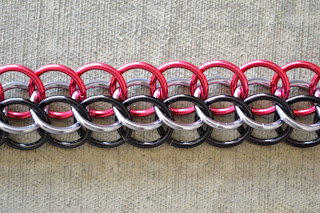Really.
I can't say it enough. And this applies to all the arts, not just chain.
There may be a technique that you are trying to learn, in which case you may be doing that technique correctly, or not, but that doesn't make the "not" wrong. It just makes it something else.
Now, why am I saying this? Simple, really. I've been asked about all the various forms of 1/2 Persian extended to more than two rows, and over and over again I am asked how to do it "correctly".
Well, dear Reader, it all depends on what you are trying to do, what effect you seek, and what it is you want.
Below you will see an example of 1/2 Persian, followed by a series of 3 row variations. The 1/2 Persian is essentially two rows of rings at a right angle to each other. When looking end-on, they basically look like a V. To add another row to one side, I can either go down, and have it look like an N, but more angled, or I can go up and have it look like a squared off U. The choice is mine.
So, as you can see, this is an example of 1/2 Persian, with one row black and one row grey. By the way, the rings that I am using are 16g 3/8 ID, in case you were wondering.
Now, the following 3 pictures will show the black on the bottom, and the grey on the top, with the grey overlapping on the left side. In other words, from left to right, the black links are going through 2 grey on the left side and 1 on the right. What I have done in each case is add another row of red on the top of the weave, going through the grey.
I had to reverse the direction of the photo in the fourth picture, or else you wouldn't be able to see what was happening, but the idea is still the same.
At this point, when I want to add a third row, I have a choice. I can go through 2 links on the left, or 2 on the right. I can also go, from left to right, either above the rings on the left, or below the rings on the left.
In the first two examples I am going through 1 on the left and 2 on the right. In the first I am going below the red links on the left and uphill to the right, while in the second I am going above them and downhill to the right. To simplify, in the first example, I reference it as 1-2 U, or 1 link, 2 links, uphill. The second is 1 -2 D, or 1 link, 2 links, downhill. The 1-2 U and 1-2 D refer to the way in which I added the red links.
1/2 Persian, 1-2 U, 3 rows
1/2 Persian, 1-2 D, 3 rows
You will notice, especially if you try it yourself, the by reversing the black and red, you extend the weave further along sideways. In other words, the black is 2-1, while the red is 1-2, and this moves the weave further away from the center or the black/grey weave. It makes it wider. This is great if you want to make wider bracelets.
Now, in the following example, I am going through 2 grey links on the left and 1 on the right, above the red links on the left, or downhill to the right. This is also known as 3/4 Persian, as it is basically a full Persian bracelet with a single row missing.
1/2 Persian, 2-1 D, 3 rows, or 3/4 Persian
Finally, here I added the red links through 2 grey links on the left and 1 on the right, below the red links on the left, or uphill to the right. In other words, all I have done is double up the black rings with the red rings.
1/2 Persian, 2-1 U, 3 rows
In these last two examples, when the red goes through the same number as the black, either 1-2 or 2-1, it brings the weave back upon itself. This is great if you want to make the piece more dense.
All of these variants are beautiful, good and useful.
Now, I'm not sure if any of this made any sense, but I'm hoping it was useful. If you have any questions, this is just a working copy of my thoughts and I will be glad to edit it as you all see fit.
Oh, below is a link to a video my friend Francois made of me beginning 1/2 Persian. I hope this all makes it easier. Perhaps I'll load a video of my own doing each of these variants. Let me know what you think.
How to begin 1/2 Persian:
https://www.facebook.com/godoflordy/videos/10155455603899637/




